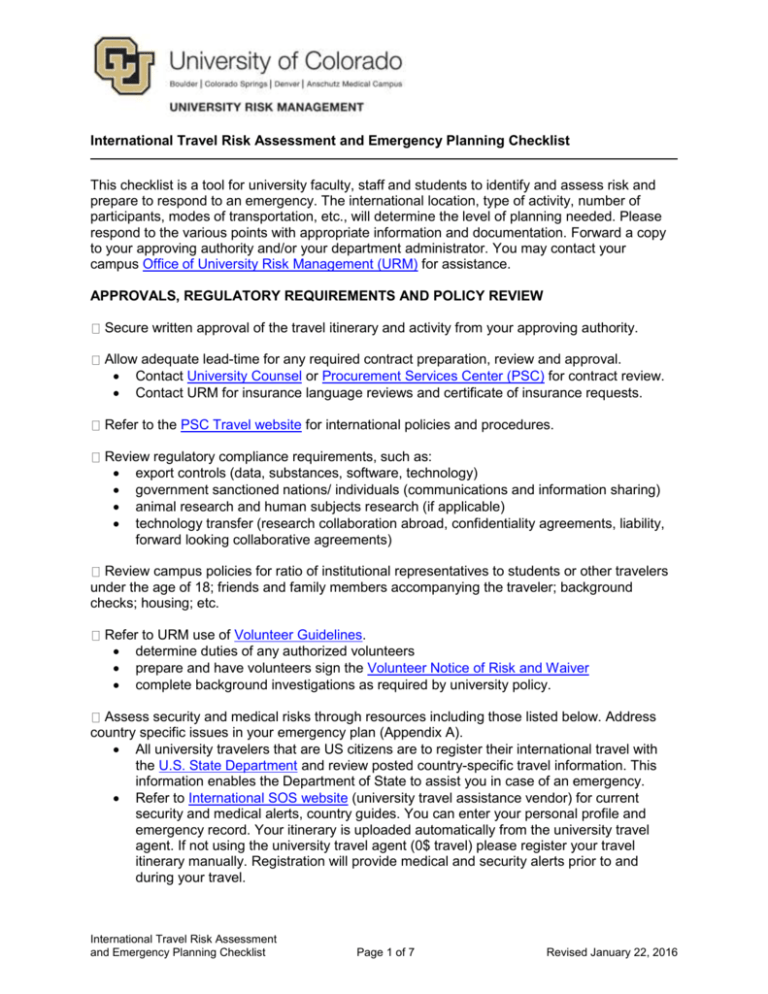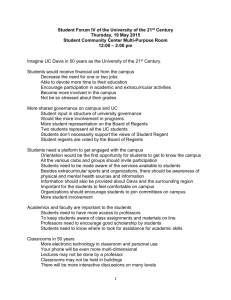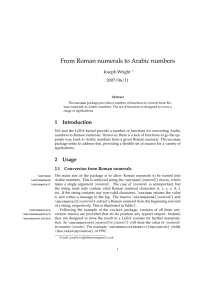Risk Assessment and Emergency Planning Checklist
advertisement

International Travel Risk Assessment and Emergency Planning Checklist This checklist is a tool for university faculty, staff and students to identify and assess risk and prepare to respond to an emergency. The international location, type of activity, number of participants, modes of transportation, etc., will determine the level of planning needed. Please respond to the various points with appropriate information and documentation. Forward a copy to your approving authority and/or your department administrator. You may contact your campus Office of University Risk Management (URM) for assistance. APPROVALS, REGULATORY REQUIREMENTS AND POLICY REVIEW Secure written approval of the travel itinerary and activity from your approving authority. Allow adequate lead-time for any required contract preparation, review and approval. Contact University Counsel or Procurement Services Center (PSC) for contract review. Contact URM for insurance language reviews and certificate of insurance requests. Refer to the PSC Travel website for international policies and procedures. Review regulatory compliance requirements, such as: export controls (data, substances, software, technology) government sanctioned nations/ individuals (communications and information sharing) animal research and human subjects research (if applicable) technology transfer (research collaboration abroad, confidentiality agreements, liability, forward looking collaborative agreements) Review campus policies for ratio of institutional representatives to students or other travelers under the age of 18; friends and family members accompanying the traveler; background checks; housing; etc. Refer to URM use of Volunteer Guidelines. determine duties of any authorized volunteers prepare and have volunteers sign the Volunteer Notice of Risk and Waiver complete background investigations as required by university policy. Assess security and medical risks through resources including those listed below. Address country specific issues in your emergency plan (Appendix A). All university travelers that are US citizens are to register their international travel with the U.S. State Department and review posted country-specific travel information. This information enables the Department of State to assist you in case of an emergency. Refer to International SOS website (university travel assistance vendor) for current security and medical alerts, country guides. You can enter your personal profile and emergency record. Your itinerary is uploaded automatically from the university travel agent. If not using the university travel agent (0$ travel) please register your travel itinerary manually. Registration will provide medical and security alerts prior to and during your travel. International Travel Risk Assessment and Emergency Planning Checklist Page 1 of 7 Revised January 22, 2016 Other English-language resources include the Australian Department of Foreign Affairs and Trade, the British Foreign and Commonwealth Office, and the Department of Foreign Affairs and International Trade, Canada. Consult the World Health Organization website for medical warnings and immunization requirements. Consult the Centers for Disease Control and Prevention website for additional travelers’ health information. Follow campus procedures for travel to countries with State Department travel warnings or university restrictions. Refer to insurance section below for travel requirements to specific high risk countries. Review relevant destination laws and regulations. ORIENTATION Contact your campus office responsible for international education for orientation assistance and guidance. Prepare written orientation materials to include information addressing various risk exposures. Consider experience and age of participants and include parents when minor children will be participating. Provide an overview, clear description and special requirements of the international travel for the participant orientation. For example: equipment dictated by weather, wild animals, water, or other site conditions fitness including varying levels for terrain language barriers locations to be visited money matters safety clothing safety training special skills terrain-specific safety transportation travel, food and lodging arrangements university insurance information Consider cultural differences that may exist at the destination; provide necessary crosscultural orientation, training and resources for participants and group leaders. Consider the interaction of persons, social, and instructional activities in an international situation. Be aware of how the situation, setting, and personal conduct may be perceived by participants and those with whom event participants may interact. Review with participants pertinent university and campus policies (e.g. drug and alcohol, sexual harassment, student code of conduct), and compliance with local laws, use of alcohol. Establish and clarify academic policy and standards (e.g. class attendance, credit, grading, cancellation criteria, tuition refunds). Review and clarify refund/cancellation policies for housing providers. International Travel Risk Assessment and Emergency Planning Checklist Page 2 of 7 Revised January 22, 2016 Establish procedures related to unplanned/unscheduled field trips, independent travel, and appropriate use of free time during the program and program cancellation. Any student travel outside of the program will not receive the privileges and protections offered by university programs. The university reserves the right to amend any program as conditions change. Prepare written orientation materials to include information addressing various risk exposures, policies and procedures, itinerary, International SOS, emergency plan, etc. WAIVERS In addition to the orientation, obtain completed and signed waivers/releases/consent forms to make sure all participants are fully informed and consent to the activities, personal risks, and potential hazards. Select the appropriate waiver/release forms for participants, volunteers and family members. Revise the waiver/release to include a description of the specific risks of the international travel. TRANSPORTATION Public transportation: Determine methods of transportation in advance of the trip and plan routes with the appropriate public transportation type. Public transportation is normally preferred. Contact URM and campus counsel to review contracted transportation (shuttle, car services, etc.) Bus charters, aircraft, or watercraft leases: If utilizing these methods, have contracts reviewed in advance to assure appropriate liability transfer and insurance requirements are included. Consult your campus URM regarding coverage exclusions for aircraft and watercraft. Rental vehicles: You must purchase country-specific compulsory auto insurance if you rent a vehicle. International car rental does not trigger liability or physical damage coverage through the State of Colorado Auto Rental Agreements. Employees using rental vehicles should consult the PSC Travel website for policies and procedures to rent a vehicle and to determine insurance coverage provided by the university’s travel credit card program. Failure to follow the correct procedure may result in personal responsibility for rental vehicle damages. INTERNATIONAL MEDICAL, INSURANCE AND ASSISTANCE University insurance: Review the URM website for information on international insurance and assistance programs. Contact campus URM with questions. International medical and evacuation insurance: If you are a student traveler or a faculty member sending or accompanying students abroad, contact your campus study abroad office for your specific requirements and insurance pertaining to student international travel. CU provides employees (faculty/staff/residents/fellows, not students—unless employed by the university and traveling as part of their employment) with international medical and evacuation insurance that covers medical emergencies, security emergencies, or natural disasters through GeoBlue (HTH Worldwide Services). o You can find more information about the policy at www.geo-blue.com using the university Group Access Code: QHG99999UCBT. It is important that you have this emergency contact information, ID card and understand the coverages and International Travel Risk Assessment and Emergency Planning Checklist Page 3 of 7 Revised January 22, 2016 o o exclusions of this policy. This coverage does not apply to flight or other travel interruptions, cancellations, or delays. This policy covers international travel meeting the following criteria: CU faculty/staff traveling outside of the U.S. or its territories CU faculty/staff traveling less than 180 consecutive days CU faculty/staff up to age 85 Please note that any travel to Afghanistan, Algeria, Burma/Myanmar, Cuba, Egypt, Guinea, Iran, Iraq, Liberia, Libya, Niger, North Korea, Sierra Leone, Somalia, South Sudan, Sudan, Syria, or Yemen requires insurer pre-approval. For travel to any of these countries please email University Risk Management at riskmgmt@cu.edu and your campus international contact with the countries to be visited, the dates to and from, and the purpose and activity during the travel. Centers for Disease Control and Prevention recommends international travelers consult a professional travel health clinic or a healthcare provider familiar with international travel. They can provide information on health conditions, advice about pre-existing conditions that may require management while you are abroad, and have access to recommended and required prophylactic medications and vaccines. Note that travel to any foreign nation with prescription medications may require medical documentation. International Travel Risk Assessment and Emergency Planning Checklist Page 4 of 7 Revised January 22, 2016 EMERGENCY RESPONSE PLAN (TEMPLATE APPENDIX A) Provide a written emergency response plan that is country and travel specific. Identify likely, foreseeable emergencies (examples below), have a plan, and conduct appropriate emergency response training for participants and staff. Civil unrest or other security related issues Communication device failure in remote locations Need for others to contact participants Need to unexpectedly return home Injury, illness or death of participants or group leaders Participant or group leader behavioral issues Theft or other crimes Vehicle accidents or breakdown Weather-related emergencies Identify official and personal emergency contacts and set up a crisis phone tree (“who calls who”) in the event of an emergency Develop a communication plan and back up (cell phone/satellite phone/laptop/etc.) Develop meeting places for evacuation or gathering locations in emergency situations— city by city Names and phone numbers of emergency personnel (police, fire, ambulance, nearby urgent care and hospital) Names and numbers of other important contacts, International SOS, URM, International Health insurance, Transportation, Incountry contacts, etc. Names and phone numbers of campus departments and dispatch and an afterhours Sponsoring Department and International Education contact Names and phone numbers of participant emergency contacts Prepare first aid kit and emergency kit with provisions, e.g. flashlight, batteries, blankets, water, bandages, energy bars, etc. Implement security measures for participants, personal property and university-owned or leased property. Personal property (not university-owned) is the owners’ responsibility. Provide and discuss with group leaders, coordinators, departmental contact, approving authority, and other key persons an up-to-date copy of the written plan for the travel. Determine cell phone coverage for areas prior to travel. Special satellite phones may be an option for remote areas. Participants should be involved in emergency planning to address their needs for appropriate assistance during a medical emergency as well as insure their familiarity with the plan. Advise participants of potential issues that could arise from injury/illness situations so that they can properly plan for their specific needs (e.g. accessibility, allergies, medical insurance, medication, etc.). Review language issues as they may apply to emergency situations. Retain documentation of the international travel including orientation materials, contracts and waivers in accordance with APS 2006 - Retention of University Records Policy. International Travel Risk Assessment and Emergency Planning Checklist Page 5 of 7 Revised January 22, 2016 APPENDIX A: EMERGENCY RESPONSE PLAN (SAMPLE TEMPLATE) This is a sample emergency plan template. Each international trip will require emergency components specific to the travel. Provide all travelers with appropriate emergency information and the plan. Provide your department/International Education/Risk Management with a plan copy. International Travel Dates: Departure ____________________ Return to US ____________________ International Itinerary (flight numbers, airport name & location, in country travel and lodging) CONTACT INFORMATION (insert additional rows as required for all travelers) Name, Title Email Address FACULTY AND STAFF Phone/Cell Fax Address Name, Title Email Address STUDENTS Phone/Cell Fax Address FACULTY AND STAFF Phone Address Type Comments Campus specific dispatch can locate faculty/staff Direct: including the emergency Campus Police response team, integrated Collect: communications, legal, and student life after hours Toll Free: and on weekends. Insert your campus info. DESTINATION EMERGENCY CONTACT INFORMATION (By Country/Region/City) Type Phone Address Comments Determine the emergency Emergency Country specific process in the area you are traveling Hospital Ambulance Police Fire Department First responder to all medical and evacuation needs. Identify the carrier and contact information. International Health Insurance Contacts International SOS (toll-free) 1-800-523-6586 (collect) 1-215-942-8226 As applicable for each destination You may want to include email addresses US Embassy URM Emergency URM Contact International Travel Risk Assessment and Emergency Planning Checklist Can respond to travel questions. Page 6 of 7 Revised January 22, 2016 EMERGENCY RESPONSE PLAN PROCEDURES (Develop your own country specific procedures relevant to your travel, see examples below): passport and visas o identify your emergency contact and have them keep photocopies of these documents financial contingency procedures for emergency needs crime o determine country specific process for handling anticipated types of crimes o in-country emergency contact information weather-related emergencies o be prepared for anticipated country specific types of weather emergencies transportation accidents or breakdown o determine emergency contacts and procedures loss or damage to university property: o contact URM to file claim and get further direction o if critical to trip, determine ability to replace and how soon loss or damage to personal property of participant o if critical to trip, determine ability to replace and how soon (note, university’s insurance does not cover personal property) behavioral and medical issues o determine appropriate country specific procedures for behavioral and medical issues o if placing other participants/employees in danger, contact local police o call parents or other emergency contact leader injury, illness, or death o follow in-country procedure for appropriate response o co-leader or assistant leader assumes the lead o consider participants safety during emergency and after if leader cannot continue o contact campus and department for assistance and guidance (campus dispatch can locate campus police, legal, communications, student affairs and other stakeholders to assist in the emergency) o contact parents or other emergency contacts, should this change the elements of the trip o reassess risks to participants should the situation warrant changes, taking care not to place participants at unnecessary or heightened risk URM incident reporting—any incident should be reported through the URM website if available at your location. Please provide international contact information, as we may need to contact you prior to your return. o For additional claim information contact URM at 303-860-5682 or toll-free 888812-9601 (note: toll-free calling may not be available at all international locations). o report work related injuries or illnesses on URM website o report auto, general liability, or property losses on URM website Provide each university traveler with International SOS country-specific information o Website: for access to all the information on International SOS, login to the website and type the membership number 11BCAS000006 into the members’ login box on the top right. When using the university travel agency an automatic upload of your reservation is sent to International SOS. This will trigger a “country guide” e-mail with medical and security information and tailored e-mail alerts throughout the travel period. You can create a profile on this page and enter your travel info if not using the university travel agency ($0 travel). International Travel Risk Assessment and Emergency Planning Checklist Page 7 of 7 Revised January 22, 2016







